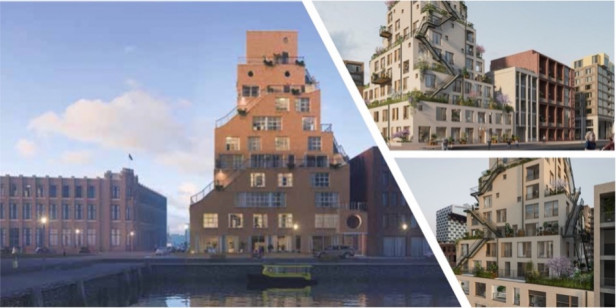This is the 16th episode of a series 25 building blocks to create better streets, neighbourhoods, and cities. This post is about one of the most important contributions to the quality of the living environment, a pleasant (family)home.
It is generally assumed that parents with children prefer a single-family home. New construction of this kind of dwelling units in urban areas will be limited due to the scarcity of land. Moreover, there are potentially enough ground-access homes in the Netherlands. Hundreds of thousands have been built in recent decades, while families with children, for whom this type of housing was intended, only use 25% of the available housing stock. In addition, many ground-access homes will become available in the coming years, if the elderly can move on to more suitable housing.
The stacked house of your dreams
It is expected that urban buildings will mainly be built in stacks. Stacked living in higher densities than is currently the case can contribute to the preservation of green space and create economic support for facilities at neighbourhood level. In view of the differing wishes of those who will be using stacked housing, a wide variation of the range is necessary. The main question that arises is what does a stacked house look like that is also attractive for families with children?
Area developer BPD (Bouwfonds Property Development) studied the housing needs of urban families based on desk research, surveys and group discussions with parents and children who already live in the city and formulated guidelines for the design of 'child-friendly' homes based on this.
Another source of ideas for attractive stacked construction was the competition to design the most child-friendly apartment in Rotterdam. The winning design would be realized. An analysis of the entries shows that flexible floor plans stand head and shoulders above other wishes. This wish was mentioned no less than 104×. Other remarkably common wishes are collective outdoor space [68×], each child their own place/play area [55×], bicycle shed [43×], roof garden [40×], vertical street [28×], peace and privacy [27× ], extra storage space [26×], excess [22×] and a spacious entrance [17×].
Flexible layout
One of the most expressed wishes is a flexible layout. Family circumstances change regularly and then residents want to be able to 'translate' to the layout without having to move. That is why a fixed 'wet unit' is often provided and wall and door systems as well as floor coverings are movable. It even happens that non-load-bearing partition walls between apartments can be moved.
Phased transition from public to private space
One of the objections to stacked living is the presence of anonymous spaces, such as galleries, stairwells, storerooms, and elevators. Sometimes children use these as a play area for lack of anything better. To put an end to this kind of no man's land, clusters of 10 – 15 residential units with a shared stairwell are created. This solution appeals to what Oscar Newman calls a defensible space, which mainly concerns social control, surveillance, territoriality, image, management, and sense of ownership. These 'neighborhoods' then form a transition zone between the own apartment, the rest of the building and the outside world, in which the residents feel familiar. Adults indicate that the use of shared cars should also be organized in these types of clusters.
Variation
Once, as the housing market becomes less overburdened, home seekers will have more options. These relate to the nature of the house (ground floor or stacked) and - related thereto - the price, the location (central or more peripheral) and the nature of the apartment itself. But also, on the presence of communal facilities in general and for children in particular.
Many families with children prefer that their neighbors are in the same phase of life and that the children are of a similar age. In addition, they prefer an apartment on the ground floor or lower floors that preferably consists of two floors.
Communal facilities
Communal facilities vary in nature and size. Such facilities contain much more than a stairwell, lift and bicycle storage. This includes washing and drying rooms, hobby rooms, opportunities for indoor and outdoor play, including a football cage on the roof and inner gardens. Houses intended for cohousing will also have a communal lounge area and even a catering facility.
However, the communal facilities lead to a considerable increase in costs. That is why motivated resident groups are looking for other solutions.
Building collectively or cooperatively
The need for new buildings will increasingly be met by cooperative or collective construction. Many municipalities encourage this, but these are complicated processes, the result of which is usually a home that better meets the needs at a relatively low price and where people have got to know the co-residents well in advance.
With cooperative construction, the intended residents own the entire building and rent a housing unit, which also makes this form of housing accessible to lower incomes. With collective building, there is an association of owners, and everyone owns their own apartment.
Indoor and outdoor space for each residential unit
Apartments must have sufficient indoor and outdoor space. The size of the interior space will differ depending on price, location and need and the nature of the shared facilities. If the latter are limited, it is usually assumed that 40 - 60 m2 for a single-person household, 60 - 100 m2 for two persons and 80 - 120 m2 for a three-person household. For each resident more about 15 to 20 m2 extra. Children over 8 have their own space. In addition, more and more requirements are being set for the presence, size, and safety of a balcony, preferably (partly) covered. The smallest children must be able to play there, and the family must be able to use it as a dining area. There must also be some protection against the wind.
Residents of family apartments also want their apartment to have a spacious hall, which can also be used as a play area, plenty of storage space and good sound insulation.
'The Babylon' in Rotterdam
De Babel is the winning entry of the competition mentioned before to design the ideal family-friendly stacked home (see title image). The building contains 24 family homes. All apartments are connected on the outside by stairs and wide galleries. As a result, there are opportunities for meeting and playing on all floors. The building is a kind of box construction that tapers from wide to narrow. The resulting terraces are a combination of communal and private spaces. Due to the stacked design, each house has its own shape and layout. The living areas vary between approximately 80 m2 and 155 m2 and a penthouse of 190 m2. Dimensions and layouts of the houses are flexible. Prices range from €400,000 – €1,145,000 including a parking space (price level 2021).
As promised, the building has now been completed, albeit in a considerably 'skimmed-down' form compared to the 'playful' design (left), no doubt for cost reasons. The enclosed stairs that were originally planned have been replaced by external steel structures that will not please everyone. Anyway, it is an attractive edifice.





